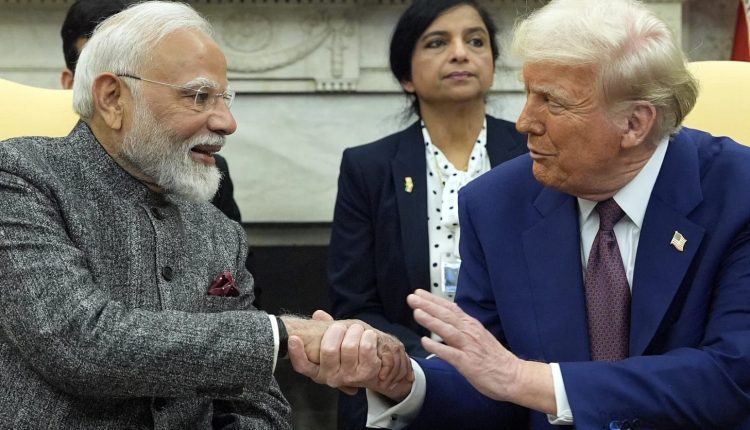By TN Ashok ,
August 05 , 2025
youtube.com/@theflagpost
*India is in the eye of a global geopolitical storm and it’s handling the heat with remarkable finesse.
President Donald Trump is back in the White House, breathing fire over India’s oil imports from Russia. In a fiery tweet storm, he slapped a 25% tariff on Indian goods, accused India of “funding Putin’s war machine,” and called the Indian economy “dead.” But instead of panic, New Delhi is responding with calm defiance and strategic maturity.
At the center of this global tug-of-war is Prime Minister Narendra Modi, who’s walking a tightrope between energy security and geopolitical alignment. He’s refusing to buckle to Trump’s pressure, defending India’s Russian oil strategy, and keeping diplomatic channels open with Washington—all while securing India’s place as the world’s fastest-growing major economy.

Oil Diplomacy: Not Ideology, Just Economics
India’s shift toward Russian crude wasn’t a political move, it was a strategic necessity. Before the Ukraine war in 2022, Russia supplied just 0.2% of India’s oil. Today, it’s over 40%, making Moscow New Delhi’s largest energy partner.
Why the pivot? Because Russian oil came cheap—$30 to $40 below Brent prices—saving India over $13 billion across two years, per rating and research agency ICRA data. In a country that imports 85% of its oil needs, those savings matter. They’ve gone into infrastructure, welfare, and managing inflation. While the West slapped sanctions on Moscow, India saw an opportunity—and took it. No apologies. Just economic sense.
Trump’s Tariff Tantrum: Tweets, Threats, and Trade War
Donald Trump, true to form, went ballistic. His administration has imposed 25% tariffs on Indian exports and threatened secondary sanctions unless India halts Russian oil purchases within 50 days. On social media, he thundered that India—alongside China—is “keeping Putin alive.”
But Modi’s response? No bluster. No outrage. Just quiet resolve. “India’s energy security will always reflect our national interest. We value all our partnerships equally,” he said in a restrained statement. That restraint plays well at home. Modi’s image as a leader who won’t bow to foreign pressure has only grown. In Indian politics, standing up to Trump boosts credibility, much like Indira Gandhi’s defiance of Nixon once did. Many now say Modi is cruising toward a fourth term, buoyed by nationalistic pride and a booming economy.
IMF vs Trump: Dead Economy? Think Again
Trump may call India’s economy “dead,” but the International Monetary Fund (IMF) tells a different story. In its latest projections: India’s GDP is set to grow at 6.8%, the fastest among major economies. India is already tied with Japan at $4.19 trillion GDP, poised to leapfrog it soon. It has overtaken the UK and is on track to beat Germany next. Compare that to: U.S.: 1.8% growth, China: 4.0% and Germany: 0.1%
India isn’t dying—it’s driving global growth. The country’s demographics are unmatched. Over 600 million Indians are under the age of 35, fuelling consumption, innovation, and services. India is a tech powerhouse, a pharma supplier to the U.S., and a hub for multinationals from Apple to Google. The world sees opportunity—even if Trump doesn’t.
Russia: A Relationship Rooted in History
India’s deep ties with Russia go beyond oil. Since the Cold War, Moscow has been India’s top defense partner, supplying nearly 70% of military hardware. From BrahMos missiles to nuclear submarines, Russia is embedded in India’s strategic architecture.
When the Ukraine war began, Russia needed buyers for its sanctioned oil. India and China stepped in—but India didn’t align with Russia politically. It remained neutral, abstained at the UN, and called for diplomacy over warfare. That neutrality, however, is not passivity. India has walked a careful line—protecting its interests without becoming a pawn in the East-West conflict. It’s a move admired in much of the Global South, even if it irks Washington.
The Modi Doctrine: Firm, Calm, and Future-Focused
Unlike many global leaders, Modi didn’t react emotionally to Trump’s threats. There were no retaliatory tariffs, no diplomatic escalation. Instead, his government doubled down on:
Trade diversification with the EU, UK, and ASEAN; energy corridor expansion (Kazakhstan, Iran, Guyana) and green transition through solar, ethanol, and EVs. He’s playing the long game—building leverage without burning bridges.
Modi’s goal? A $5 trillion economy by 2027. Even with Trump breathing down his neck, India is negotiating a potential $530 billion trade deal with the U.S. That’s not submission—it’s strategic engagement.
Washington’s Dilemma: Friend or Foe?
India is central to America’s Indo-Pacific strategy. It’s a key Quad member. It shares maritime interests. And it’s the only major democracy that can counterbalance China in Asia. But Trump’s tariff war threatens to derail that alignment. Push too hard, and the U.S. risks driving India closer to BRICS+ and SCO, where China and Russia lead.
Even in Washington, the backlash is growing. Bipartisan voices on Capitol Hill are questioning Trump’s approach. They know India isn’t Russia. It’s not China. It’s a democracy that shares American values—even if their policies sometimes diverge.
Conclusion: Not a Pawn. A Player.
India’s foreign policy under Modi can’t be boxed in. It’s not non-aligned, not pro-Russia, not anti-West. It’s India First—and unapologetically so. In the current storm over Russian oil and Trump’s tariffs, India is proving something powerful: it can stand its ground, protect its economy, and still talk to both superpowers. That’s not fence-sitting. That’s real politik at its best. As crude flows and Trump fumes, Modi navigates—steady hands on the wheel of a rising power.


